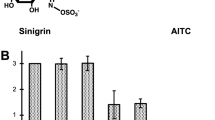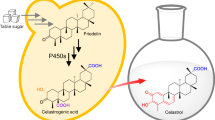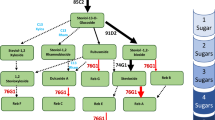Abstract
Consumption of cruciferous vegetables is associated with reduced risk of developing cancer, a phenomenon attributed to glucosinolates, which are characteristic of these vegetables. We report production of the bioactive benzylglucosinolate in the noncruciferous plant Nicotiana benthamiana through metabolic engineering. The study includes identification of γ-glutamyl peptidase 1 (GGP1), which substantially increased glucosinolate production by metabolizing an accumulating glutathione conjugate, an activity not previously described for glucosinolate biosynthesis or for proteins containing glutamine amidotransferase domains.
This is a preview of subscription content, access via your institution
Access options
Subscribe to this journal
Receive 12 print issues and online access
$259.00 per year
only $21.58 per issue
Buy this article
- Purchase on Springer Link
- Instant access to full article PDF
Prices may be subject to local taxes which are calculated during checkout


Similar content being viewed by others
Accession codes
References
Hayes, J.D., Kelleher, M.O. & Eggleston, I.M. Eur. J. Nutr. 47, 73–88 (2008).
Higdon, J.V., Delage, B., Williams, D.E. & Dashwood, R.H. Pharmacol. Res. 55, 224–236 (2007).
International Agency for Research on Cancer Workgroup. Cruciferous Vegetables, Isothiocyanates and Indoles (IARC Press, Lyon, France, 2004).
Halkier, B.A. & Gershenzon, J. Annu. Rev. Plant Biol. 57, 303–333 (2006).
Juge, N., Mithen, R.C. & Traka, M. Cell. Mol. Life Sci. 64, 1105–1127 (2007).
Clarke, J.D., Dashwood, R.H. & Ho, E. Cancer Lett. 269, 291–304 (2008).
Traka, M. et al. PLoS One 3, e2568 (2008).
Hansen, C.H. et al. J. Biol. Chem. 276, 24790–24796 (2001).
Schlaeppi, K., Bodenhausen, D., Buchala, A., Mausch, F. & Reymond, P. Plant J. 55, 774–786 (2008).
Hayashi, H. J. Biochem. 118, 463–473 (1995).
Schwimmer, S. & Kjaer, A. Biochim. Biophys. Acta 42, 316–324 (1960).
Martin, M.N., Saladores, P.H., Lambert, E., Hudson, A.O. & Leustek, T. Plant Physiol. 144, 1715–1732 (2007).
Kurihara, S., Oda, S., Kumagai, H. & Suzuki, H. FEMS Microbiol. Lett. 256, 318–323 (2006).
de Felipe, P. et al. Trends Biotechnol. 24, 68–75 (2006).
Geu-Flores, F., Olsen, C.E. & Halkier, B.A. Planta 229, 261–270 (2009).
Voinnet, O., Rivas, S., Mestre, P. & Baulcombe, D. Plant J. 33, 949–956 (2003).
Saito, K., Hirai, M.Y. & Yonekura-Sakakibara, K. Trends Plant Sci. 13, 36–43 (2008).
Kleinwächter, M., Schnug, E. & Selmar, D. J. Agric. Food Chem. 56, 11165–11170 (2008).
Charron, C.S., Saxton, A.M. & Sams, C.E. J. Sci. Food Agric. 85, 671–681 (2005).
Acknowledgements
We thank the Danish International Developmental Agency for a PhD stipend to F.G.-F. (DANIDA project no. 91175) and the Villum Kann Rasmussen Fond for its support to the VKR Research Centre for Pro-Active Plants. We also thank Novozymes for the Novo Scholarship to M.T.N. and M.E.M.
Author information
Authors and Affiliations
Contributions
F.G.-F. and B.A.H. formulated the project; M.T.N. and M.E.M. performed experiments in N. benthamiana; F.G.-F. and M.N. expressed GGP1 in E. coli and performed kinetic measurements; M.S.M. synthesized GS-B; C.E.O. performed LC-MS analysis; F.G.-F. and M.T.N. analyzed the data; F.G.-F., M.T.N. and B.A.H. wrote the manuscript.
Corresponding author
Ethics declarations
Competing interests
The heterologous production of glucosinolates is the subject of a PCT patent application filed 27 February 2009 (PCT/IB2009/000500).
Supplementary information
Supplementary Text and Figures
Supplementary Figures 1–3, Supplementary Scheme 1 and Supplementary Methods (PDF 309 kb)
Rights and permissions
About this article
Cite this article
Geu-Flores, F., Nielsen, M., Nafisi, M. et al. Glucosinolate engineering identifies a γ-glutamyl peptidase. Nat Chem Biol 5, 575–577 (2009). https://doi.org/10.1038/nchembio.185
Received:
Accepted:
Published:
Issue Date:
DOI: https://doi.org/10.1038/nchembio.185
This article is cited by
-
Tripterygium wilfordii cytochrome P450s catalyze the methyl shift and epoxidations in the biosynthesis of triptonide
Nature Communications (2022)
-
ADAP is a possible negative regulator of glucosinolate biosynthesis in Arabidopsis thaliana based on clustering and gene expression analyses
Journal of Plant Research (2021)
-
Bioengineering potato plants to produce benzylglucosinolate for improved broad-spectrum pest and disease resistance
Transgenic Research (2021)
-
Improvement of glucosinolates by metabolic engineering in Brassica crops
aBIOTECH (2021)
-
Effects of Sulfur and Selenium on Glucosinolate Biosynthesis in Cabbage
Plant Molecular Biology Reporter (2020)



